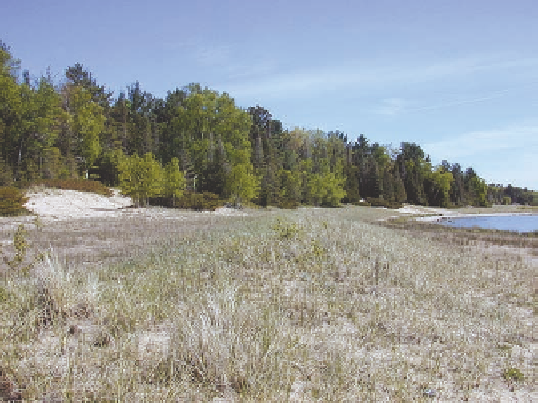Geoscience Reference
In-Depth Information
Plant Succession
Plant succession
refers to the natural changes that occur in
a biome of a particular place over time. Generally speaking,
these natural changes progress to the point where the most
complex array of vegetation possible arises, given the region-
al climate, water, and soil variables. If the succession begins
on freshly deposited sediment, then we use the term
primary
succession
. If, on the other hand, the succession occurs in an
area that was disturbed through fire or some other catastrophic
event, then the term
secondary succession
applies.
Regardless of whether the succession is primary or
secondary, the sequence of plant stages is usually predict-
able for a given area. The first plants that occupy the area are
called
pioneer species
. These plants set the stage for future
succession because they initiate the gradual change of the
host soil through root penetration and the cycling of organ-
ic material and minerals as they spread across the area. In
this fashion, bacteria and animals begin to inhabit the area,
and the site vegetation gradually becomes more complex.
In time, the local microenvironment becomes hospitable for
larger plants, which change the shading and associated mi-
croclimate at ground level. These adjustments in humidity
and soil temperature make it possible for additional plants
to move into the area. When this progression reaches the ul-
timate complexity of an area, the vegetation is said to be
climax vegetation
.
A good example of primary succession can be seen on
a sequence of coastal sand dunes, which are mounds of sand
that grow through wind deposition. They are highly mobile
landforms that move due to a complex interaction of wind and
sand supply. These landforms are relatively infertile micro-
environments because they are very well drained and nutri-
ent-poor, due to high amounts of quartz and feldspar and low
amounts of nitrogen, rcalcium, and phosphorus.
In the context of plant succession, the first plants to in-
habit a fresh deposit of wind-blown sand are beach grasses.
These grasses are adapted to the relatively infertile condi-
tions of a new sand dune and continue to grow even if they
are slightly buried by fresh deposits of sand. As they spread
across the dune and develop more complex root systems, they
cause it to stabilize, which means that the sand stops moving.
At this time, new plants move in that are adapted to the rela-
tively infertile conditions of the dune. These plants, however,
cannot tolerate the stress of being buried as the initial plants
could. When this more established successional stage occurs,
the soil chemistry and ground microenvironment continue to
evolve, culminating in the establishment of trees on the older
dunes.
Figure 10.24 Primary succession on Great Lakes coastal
dunes.
Beach grass grows on the low dune in the foreground,
which is the most recent deposit of windblown sand. The higher
dunes in the background are covered by forest because these
dunes are older and have been stable for a longer period of time.
Figure 10.24 is a scene from a coastal dune field along
Lake Michigan and is an excellent example of this succes-
sion. Compare the vegetation on the low (young) dune in the
foreground with that on the higher (older) dunes in the back-
ground. The younger dune is inhabited by beach grass, while
those in back are covered with forest. In the Great Lakes re-
gion, this succession sequence is thought to take about 150
years.
Riparian Zones
Another important factor that can influence the geographic
distribution of vegetation is proximity to water. This factor is
especially important in semi-arid regions where water is often
scarce. An example of this kind of relationship is the
ripar-
ian zone
, which is defined as the area immediately adjacent
to a stream. Such zones are suitable for trees because more
water is available for plant growth near the river than away
from it, especially because elevation increases with distance
away from the valley bottom. A good place to see how riparian
vegetation may differ from what occurs in more upland areas
can be seen in parts of the Great Plains of North America (Fig-
ure 10.25). Notice in this image that trees are growing only
along the river, while the surrounding landscape consists of
grass and sagebrush.
Plant succession
The predictable vegetation transition that
occurs within a landscape over a period of time.
Riparian zone
The strip of land bordering a body of water
that supports plants and animals adapted to water systems.
Climax vegetation
The vegetation within an area that has
reached its ultimate complexity.

